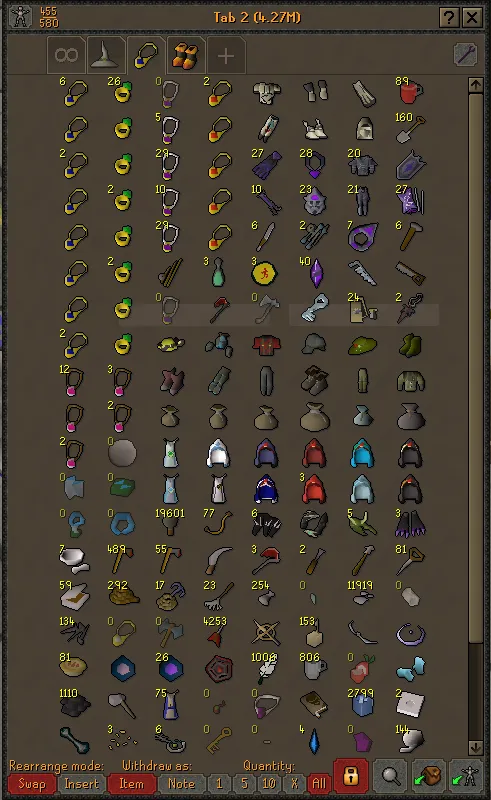Your cart is empty
How to Farm in OSRS: A Complete Guide to Mastering Farming in Old School RuneScape

Farming in Old School RuneScape (OSRS) is a unique and rewarding skill that allows players to grow crops, trees, and herbs across the vast world of Gielinor. Whether you’re aiming to level up quickly, make a profit, or simply enjoy a more passive gameplay style, mastering Farming can open up new opportunities in OSRS. This comprehensive guide will walk you through everything you need to know about how to farm in OSRS, from the basics to advanced strategies, ensuring you’re ready to cultivate your way to success. Let’s dig in!
Farming in OSRS differs from other skills because it’s largely passive—once you plant your seeds, they grow over time, even when you’re logged out. However, knowing where to plant, what tools to use, and how to manage your crops is key to success. Here’s a breakdown of the essentials.
What Is Farming in OSRS?
Farming is a skill where players plant seeds in designated patches scattered throughout Gielinor, tend to them as they grow, and harvest the produce for experience and resources. Unlike skills like Woodcutting or Mining, you don’t own a personal farm; instead, you use public patches specific to different crop types, such as allotments, trees, or herbs.
Essential Farming Tools
Before you start planting, you’ll need the right tools. Here’s a quick list of must-haves:
- Rake: Clears weeds from patches before planting.
- Seed Dibber: Plants seeds in allotments, herbs, and hops (not trees).
- Gardening Trowel: Used to plant tree seeds into plant pots to create saplings.
- Spade: Harvests fully grown crops or clears dead ones.
- Watering Can: Waters saplings and low-level crops to help them grow.
- Compost Bucket: Applies compost to reduce disease risk and boost yield.
You can store these tools with the Tool Leprechaun at any farming patch for convenience.
Types of Farming Patches
OSRS features various patch types, each suited to specific crops. Understanding these is crucial for efficient farming:
| Patch Type | Crop Examples | Growth Time |
|---|---|---|
| Allotment | Potatoes, Onions, Watermelons | 40-70 minutes |
| Herb | Ranarr, Snapdragon, Torstol | 80 minutes |
| Tree | Oak, Willow, Maple | 3-8 hours |
| Fruit Tree | Apple, Banana, Papaya | 16 hours |
| Hops | Barley, Jute, Yanillian | 40-70 minutes |
Getting Started: Low-Level Farming in OSRS
If you’re new to Farming or starting at level 1, don’t worry—there are plenty of ways to kick off your journey without overwhelming yourself. Here’s how to begin.
Questing for Early Levels
One of the fastest ways to skip the tedious early levels is by completing quests that reward Farming experience. These quests can boost you to level 35 or higher:
- Recipe for Disaster (Goblin Generals): 1,000 XP
- Fairytale I – Growing Pains: 3,500 XP
- Forgettable Tale…: 5,000 XP (requires level 17)
- Garden of Tranquillity: 5,000 XP (requires level 25)
- My Arm’s Big Adventure: 5,000 XP (requires level 29)
Completing these can get you to level 38, unlocking decent farming options right away.
Planting Allotments and Hops
At level 1, start with allotments like potatoes (level 1) or hops like barley (level 3). Use compost to protect your crops and check back after 40-70 minutes to harvest. Good starting locations include the Falador patch south of the city or the hops patch near Yanille.
Bagged Plants in Your Player-Owned House
For active training without waiting, use bagged plants in your Player-Owned House (POH). Buy bagged plants from the garden supplier in Falador Park and plant them in your garden or formal garden. A bagged plant (level 1) gives 31 XP when planted and 35 XP when removed, making it a quick way to reach level 15.
Mastering Tree Runs for Fast XP
Tree runs are the backbone of Farming training in OSRS, offering massive experience in short bursts. They’re ideal for players who want to level up quickly with minimal active time.
How Tree Runs Work
Tree runs involve planting tree or fruit tree saplings in designated patches, paying a gardener to protect them, and returning later to check their health or harvest them. Regular trees take 3-8 hours to grow, while fruit trees take 16 hours.
Tree Run Checklist
Here’s what you’ll need for an efficient tree run:
- Saplings: Combine seeds with filled plant pots (use a trowel).
- Payment: Gardener fees (e.g., 10 cacti for maple trees).
- Teleports: Fast travel options like Spirit Trees, Fairy Rings, or teleport spells.
Best Tree Run Route
Maximize efficiency with this route for regular and fruit tree patches:
- Tree Patch – Falador Park: Falador Teleport
- Tree Patch – Varrock Palace: Varrock Teleport
- Tree Patch – Lumbridge: Lumbridge Teleport
- Fruit Tree Patch – Catherby: Camelot Teleport
- Fruit Tree Patch – Gnome Stronghold: Spirit Tree
Check trees for 200-500 XP each, depending on the type, and replant as needed.
Profiting with Herb Runs
Herb runs are a profitable way to farm in OSRS, perfect for offsetting tree run costs or making consistent gold. They’re slower for XP but highly rewarding.
Why Herb Runs?
Herbs like Ranarr, Snapdragon, and Torstol are in high demand for potions, fetching 5,000-10,000 GP each. With 80-minute growth cycles, you can do multiple runs daily.
Herb Run Setup
To start, gather these:
- Herb Seeds: Buy from the Grand Exchange or Draynor Seed Market.
- Ultracompost: Reduces disease chance to 1/10 and boosts yield.
- Magic Secateurs: Increases yield by 10% (unlocked via Fairytale I).
Optimal Herb Run Route
Hit these patches in one go:
- Falador: Teleport to Falador
- Catherby: Camelot Teleport
- Ardougne: Ardougne Cloak 2
- Trollheim: Trollheim Teleport (post-My Arm’s Big Adventure)
- Hosidius: Xeric’s Talisman
Expect 50-100k GP per run, depending on herb prices and yield.
Advanced Farming Tips and Tricks
Once you’re comfortable with the basics, these advanced strategies will take your Farming to the next level.
Compost and Disease Management
Use compost wisely to protect your crops:
- Regular Compost: Halves disease chance, cheap but basic.
- Supercompost: Reduces disease to 1/5, great for mid-tier crops.
- Ultracompost: Drops disease to 1/10, best for herbs and high-value plants.
For allotments, plant flowers like marigolds (level 2) to protect adjacent patches naturally.
Teleportation Efficiency
Speed up runs with these unlocks:
- Explorer’s Ring 2+: Teleports near Falador patch.
- Ectophial: Quick access to Morytania patch (post-Ghosts Ahoy).
- Fairy Rings: Code C-I-R for Gnome Stronghold fruit trees.
Tithe Farm for Ironmen
For Ironmen or those seeking an active method, Tithe Farm (level 34+) offers decent XP and rewards like the seed box. Plant Golovanova seeds (level 34) and water them manually every 20 minutes for 6-12k XP per hour.
Farming in OSRS is a blend of patience, strategy, and efficiency. Whether you’re chasing XP with tree runs, banking gold with herb runs, or just enjoying the process, this guide has you covered. Start small, experiment with patches, and soon you’ll be a Farming pro in Gielinor. Happy planting!
